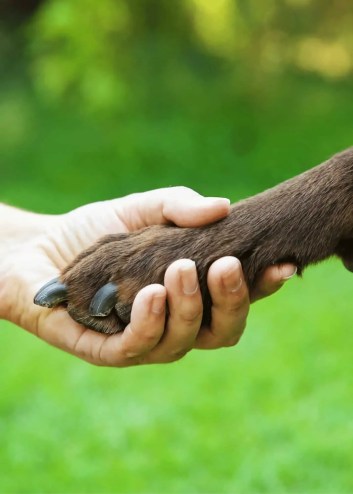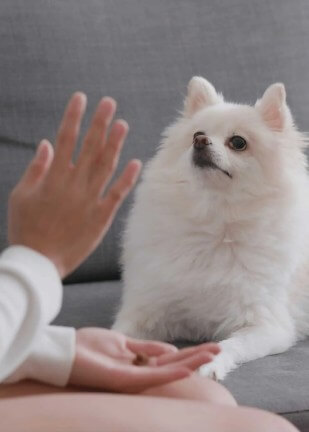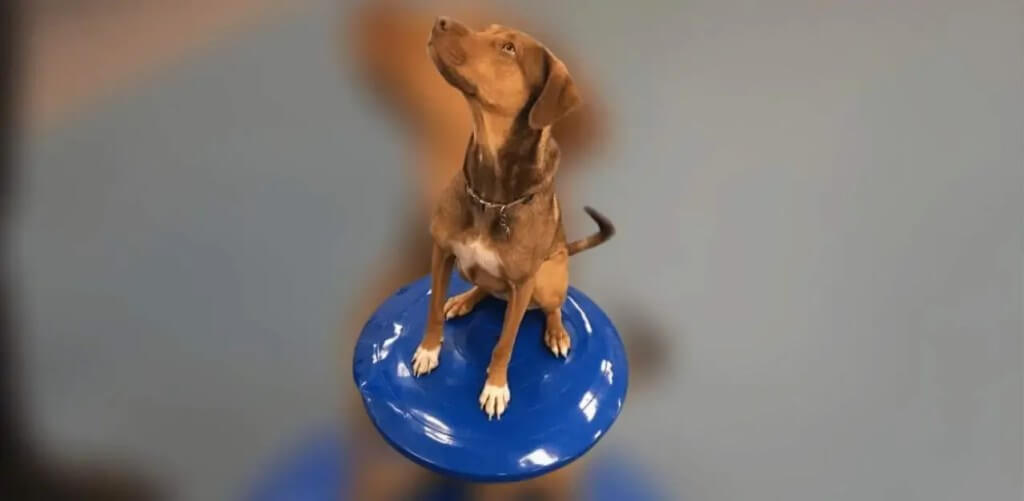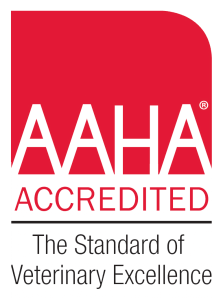Why Positive Reinforcement is the Best Course of Action
Positive reinforcement dog training techniques are the best course of action because they use non-confrontational methods to work on a dog’s brain – rewarding positive behavior.
Positive reinforcement also establishes rituals and training actions that are incompatible with unwanted behaviors. This means that if you reward a behavior you like, there is a better chance of repeated behavior. When paired with negative punishment, such as the removal or withholding something the dog wants (i.e., food) or using a vocal interrupter to redirect negative behavior, we can guide a dog into making the right choices.
The Following Two Methods are the Foundational Elements used in Positive Reinforcement Dog Training
Identifying and providing high-value rewards for good behavior is a crucial element of positive reinforcement. Food is the most used reward for dogs that are food-motivated due to its unique ability to alter brain chemistry, but other rewards such as toys, praise, and play can be just as powerful if a dog happens to be more interested in them.
The use of rewards in training is an often-misunderstood concept. Instead of thinking of rewarding your dog as bribery, consider the reward a valuable salary being paid to your dog for a job well done. If your dog does not respond, he does not get paid. If he does respond, he does get paid. Therefore, your dog learns that he can make good things happen when he does the things you like.
Positive Reinforcement Method Most Effective, Most Humane, Safest

The behavioral scientific community has universally accepted the use of positive reinforcement methods when teaching your dog as the most effective, long-lasting, humane, and safest method in dog training. There are a few essential things to remember when training with positive reinforcement, which is detailed below:
- Avoid the use of intimidation, physical punishment, or fear. Many scientific studies have shown that the use of confrontational or positive punishment training techniques does not work in the long term but can make aggressive responses occur more often and make already aggressive dogs even more aggressive. Positive punishments like these can also ruin the bond you have with your dog.
- Pet owners need to understand the often-misleading concept of dominance. This understanding will help them see that their dog’s misbehavior is very rarely a result of attempting to assert dominance over their human. To this day, I have not met a dog that I believe is plotting to take over the world. That storyline would be better left to a children’s movie than anything in real life.
- Pet owners need to understand the canine experience from the dog’s point of view. People cannot build a strong bond with their dogs unless they truly understand how they perceive the world around them. To do this well, you must learn the dog’s language and appreciate the way they experience life through sight, sound, smell, taste, and touch. Being the more advanced species, it is up to us to learn to ‘speak dog’ rather than expect our fur-babies to learn our native language. Doing this will give you the foundation to build a stronger relationship and make it easier to find effective, positive solutions for any problem behaviors your dog might have.
- A dog’s senses are closely linked to emotions, and those emotions drive its behavior. With this knowledge, it stands to reason that even though we do not fully understand the dog’s sense capabilities, they always play an integral part in the dog’s experience. It has been my experience that if your dog is food motivated, the higher the treat value is, the faster they will learn a behavior. So, find the smelliest treat you can stand to work with and watch the magic happen.
Intermittent Reinforcement

is a subsection in positive training techniques. Any reward that we use to motivate our dogs to learn must be of high value until they respond reliably. However, once this has been achieved, the high-value reward (i.e., food) should be used intermittently or randomly. That means your dog does not get rewarded with the high-value reward every time he responds to a cue, but there is a chance he might get it the next time. When the high-value reward is given, it should be set on a random schedule. If the high-value reward is not given, then a lower-value reward is presented in its place. A low-value reward might be praise for a food-motivated dog, while for a toy-motivated dog, the low-value reward might be food.
In fact, intermittent reinforcement like this has been shown to make a dog respond faster and more reliably.
This method’s theory is based on the same one that makes a slot machine in a casino so addictive to humans. It would be wonderful if a slot machine gave out money every time you played it but unfortunately, that never happens. The chance, however, that you could win the jackpot the next time you pull the lever makes you want to play even more until the slot machine pays out. I do not know about you, but if you dangle the possibility of getting a 20-dollar bill for doing the dishes in front of me, I would be more inclined to wash them each night.
This is the most effective way for a dog to learn. Even if you do not give a high-value reward every time, the potential of one in the future will make your dog work much harder.
A dog’s decision-making process should not be influenced using force. Doing so could damage your relationship and make it harder for them to learn the correct response. Your dog needs to make the correlation between the word sit and the action of putting their hind end on the floor by themselves to get the best response.
Dogs that are taught using positive reinforcement methods are more tolerant, self-controlled, and behave much more predictably in different situations. This is due in large part to the relationship with their people or
It is vitally important that you give your dog the opportunities and tools they need to live successfully in your strange human world. A dog that is given consistent guidance from an early age grows up to be confident. Thus, everyone in the family must be on the same page when training the family dog.
If Mom lets the dog on the couch, but alternatively, Dad yells at him to get off the couch, you will have a very confused and nervous dog, as your dog does not understand the different preferences between Mom and Dad. Dogs do best with consistency. This fear and confusion can lead to aggression later down the road. If you plan to bring a puppy into the family, make sure to sit everyone down for a family meeting and discuss how you all would like your new dog to act.
Positive Reinforcement Dog Training to Address Problem Behaviors

If you already have problems with your dog’s behavior, the process of changing that behavior using positive reinforcement relies first and foremost on understanding and patience. It is going to take a lot of consistency and repetition to modify your dog’s behavior.
To start, you must become a detective and investigate why your dog is doing what he is doing. You cannot effectively deal with a behavior unless you know the root cause behind it. Once you understand why it is vitally important, you know your dog’s language. Then you can ask yourself how to treat the behavior. Once you know how to communicate clearly, effective two-way communication will increase the bond between you and your dog.
Find what motivates your dog and use this while teaching. The rewards you will use come in the form of food, toys, praise, or play. These can be very powerful tools, but every dog is different, so find out what motivates your dog the most.
During the training process, remember to be kind. Never hit, scream at, or yank your dog. Do not combat fear by using techniques that cause more fear or aggression to combat aggressive behavior.
Recognize your dog’s concerns, then slowly and gently help them overcome each situation. Training using combative techniques will only exacerbate the problems you are having.
Go very slowly, especially when dealing with anxiety or fear-related behaviors. Like humans, the more significant the behavior issue, the longer it can take to develop a solution. Keep calm and stay the course. Always remember that the power of positive training is the right choice in all situations, no matter what the issue.
Lastly, be consistent. Everyone in your dog’s life must be on the same page and provide consistency with training expectations and reactions. Remember the couch analogy from earlier.
If one person in the house allows the behavior and the other does not, your dog will become confused and lash out.
At Brook-Falls Luxury Pet Resort & Doggy Day Care, our mission is to help every dog reach their full potential by using positive reinforcement.
Whether your dog is enrolled in one of our many classes, participates in enrichment style daycare, or is relaxing while lodging in one of our suites, your dog will always be met with positive reinforcement training methods by our team. If you would like to learn more about Brook-Falls’ training, enrichment daycare, or lodging, please contact us today. We will be happy to help you determine the right fit for your dog so you can enjoy a great relationship together!
Note:
Behavior Training and Socialization
About Brook-Falls
Brook-Falls Veterinary Hospital and Exotic Care is dedicated to providing quality care to all companion pets and exotic animals. Brook-Falls is a Menomonee Falls, WI-based full-service veterinary hospital with an extensive range of comprehensive medical, dental, diagnostic, and surgical services to meet the varying needs of all patients. Brook-Falls Veterinary also offers informational and educational media and seminars for pet owners by way of blogs, digital TV series (Expert Veterinary Television), e-books, whitepapers, infographics, and more.
For more information, contact Brook-Falls Veterinary Hospital & Exotic Care, Inc


